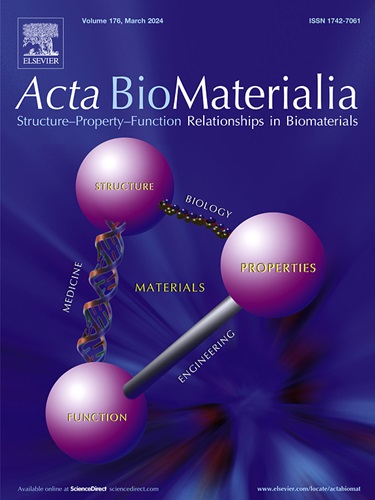Inflammation-targeted vesicles for co-delivery of methotrexate and TNF-α siRNA to alleviate collagen-induced arthritis
IF 9.4
1区 医学
Q1 ENGINEERING, BIOMEDICAL
引用次数: 0
Abstract
Rheumatoid arthritis (RA) is an autoimmune disease that has a complex pathogenesis and remains tough to treat. The clinical treatments with e.g. methotrexate (MTX) and TNF-α antibodies show fractional responses and lessen the symptoms only to a certain extent. Here, we developed inflammation-targeted vesicles codelivering methotrexate and TNF-α small interfering RNA (siTNFα) (ITV-MT) for effective ablation of collagen-induced arthritis (CIA) in mice. ITV-MT with tetra-mannose ligand and high loading of MTX (17.1 wt%) and siTNFα (9.0 wt%) displayed a small and uniform size (53 nm) and augmented uptake by inflammatory macrophages leading to superior regulation of macrophage phenotype from M1 to M2 in vitro compared to monotherapies. The intravenous injection of ITV-MT revealed clearly enhanced accretion in the inflamed joints. Interestingly, ITV-MT effectively repolarized M1 macrophages to M2 type, markedly reduced proinflammatory cytokine levels, and significantly attenuated symptoms including joint swelling, arthritis scores and bone damage in the CIA mouse models, by concurrently downregulating both adenosine and TNF-α pathways. This study highlights inflammation-targeted vesicles codelivering methotrexate and TNFα siRNA as a potential strategy to improved RA treatment.
Statement of significance
Rheumatoid arthritis (RA) is regarded as an incurable disease, often referred to as an "incurable cancer". Current therapies, such as methotrexate (MTX) and anti-TNFα monoclonal antibodies, exhibit limited efficacy and severe adverse effects. The distinct physiochemical properties of MTX and siTNFα hinder their codelivery to RA joints and inflammatory cells. Here, we engineered inflammation-targeted vesicles (ITV-MT) for the codelivery of MTX and siTNFα to enhance therapeutic outcomes. Our findings reveal that ITV-MT significantly improves the drug uptake by macrophages, facilitating repolarization from M1 to M2 phenotypes. In CIA models, ITV-MT effectively downregulated proinflammatory cytokines while upregulating anti-inflammatory cytokines in RA joints, inhibited inflammatory cell infiltration in the synovium and protected against bone erosion. This study highlights that inflammation-targeted co-delivery of small molecular anti-RA agents and RNAi therapeutics may offer a compelling alternative to existing RA treatments, representing a promising strategy for RA treatment.

甲氨蝶呤和TNFα sirna共同递送的炎症靶向小泡缓解胶原诱导的关节炎。
类风湿性关节炎(RA)是一种自身免疫性疾病,具有复杂的发病机制,仍然难以治疗。临床应用甲氨蝶呤(MTX)、TNF-α抗体等治疗,反应不明显,仅能在一定程度上缓解症状。在这里,我们开发了炎症靶向囊泡,共递送甲氨蝶呤和TNF-α小干扰RNA (siTNFα) (ITV-MT),用于有效消融小鼠胶原诱导关节炎(CIA)。具有四甘露糖配体和高负荷MTX (17.1 wt.%)和siTNFα (9.0 wt.%)的ITV-MT显示出小而均匀的尺寸(53 nm),并增强了炎症巨噬细胞的摄取,导致巨噬细胞表型从M1到M2的体外调节优于单一治疗。静脉注射ITV-MT显示炎症关节明显增强的增生。有趣的是,在CIA小鼠模型中,ITV-MT通过同时下调腺苷和TNF-α通路,有效地将M1巨噬细胞重极化为M2型,显著降低促炎细胞因子水平,并显著减轻关节肿胀、关节炎评分和骨损伤等症状。本研究强调炎症靶向囊泡共同递送甲氨蝶呤和TNFα siRNA作为改善RA治疗的潜在策略。意义声明:类风湿性关节炎(RA)被认为是一种无法治愈的疾病,通常被称为“无法治愈的癌症”。目前的治疗方法,如甲氨蝶呤(MTX)和抗tnf α单克隆抗体,疗效有限,副作用严重。MTX和siTNFα不同的理化性质阻碍了它们向RA关节和炎症细胞的共递送。在这里,我们设计了炎症靶向囊泡(ITV-MT),用于MTX和siTNFα的共同递送,以提高治疗效果。我们的研究结果表明,ITV-MT显著改善巨噬细胞的药物摄取,促进从M1到M2表型的再极化。在CIA模型中,ITV-MT有效下调RA关节的促炎细胞因子,上调抗炎细胞因子,抑制滑膜中的炎症细胞浸润,防止骨侵蚀。这项研究强调,炎症靶向的小分子抗RA药物和RNAi疗法可能为现有的RA治疗提供一个令人信服的替代方案,代表了一种有希望的RA治疗策略。
本文章由计算机程序翻译,如有差异,请以英文原文为准。
求助全文
约1分钟内获得全文
求助全文
来源期刊

Acta Biomaterialia
工程技术-材料科学:生物材料
CiteScore
16.80
自引率
3.10%
发文量
776
审稿时长
30 days
期刊介绍:
Acta Biomaterialia is a monthly peer-reviewed scientific journal published by Elsevier. The journal was established in January 2005. The editor-in-chief is W.R. Wagner (University of Pittsburgh). The journal covers research in biomaterials science, including the interrelationship of biomaterial structure and function from macroscale to nanoscale. Topical coverage includes biomedical and biocompatible materials.
 求助内容:
求助内容: 应助结果提醒方式:
应助结果提醒方式:


